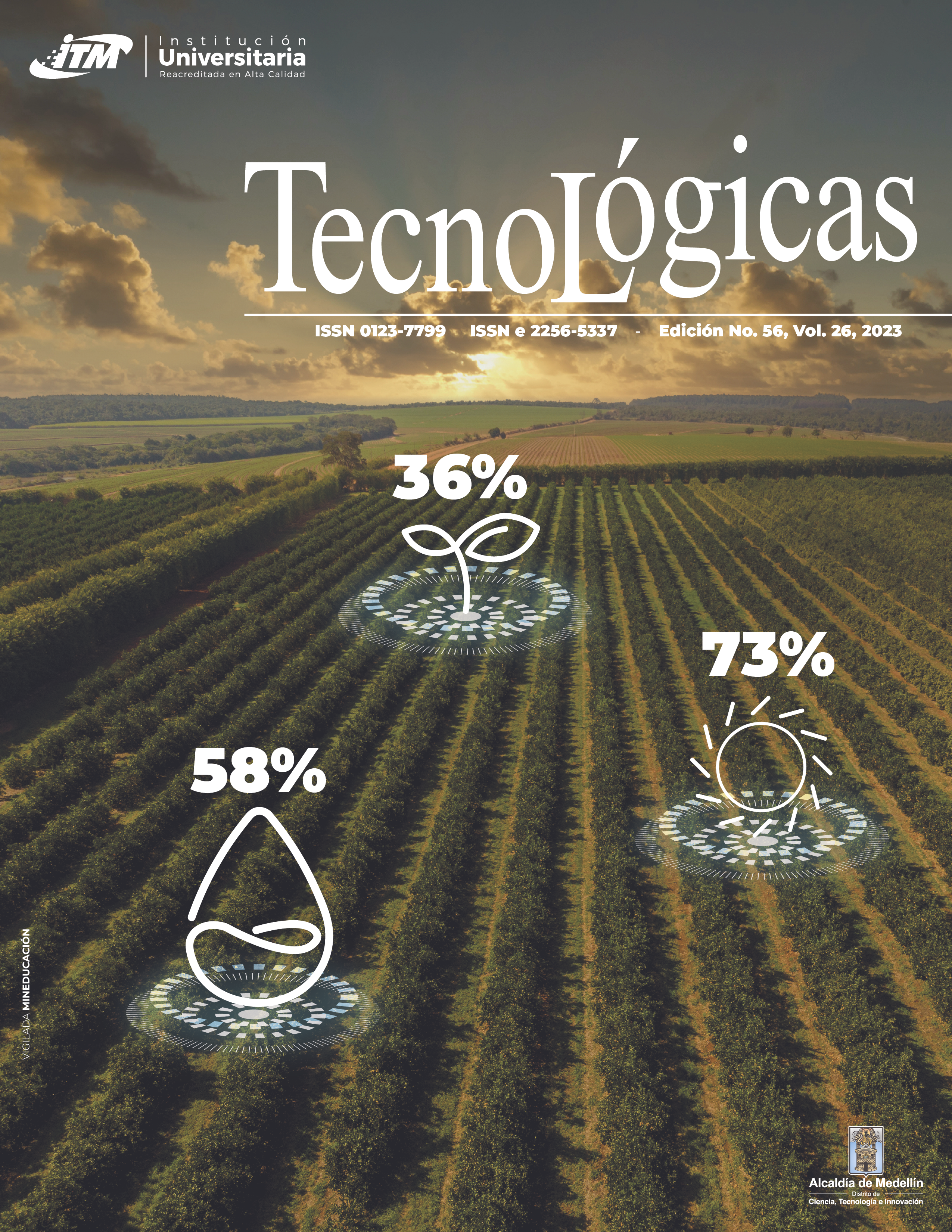Comparación computacional de motores AC y DC ante cambios hidrodinámicos en embarcaciones marítimas pesqueras
Resumen
El objetivo de este artículo fue realizar la comparación en un ambiente computacional entre un motor de corriente alterna y un motor de corriente continua ante variaciones dinámicas en la propulsión de una embarcación marítima de pesca artesanal. Inicialmente, se simuló la embarcación en el software Maxsurf con el objetivo de obtener los comportamientos dinámicos para los movimientos de cabeceo, balanceo, guiñada y oleaje con perturbaciones de viento y ola para un espectro de Pierson-Moskowitz. Posteriormente, se seleccionaron los motores en el software Matlab/Simulink, donde se propone un comportamiento de torque requerido por la embarcación para actuar ante la resistencia presentada en cada movimiento dinámico. Esto permitió analizar las condiciones mecánicas y eléctricas requeridas mediante las curvas obtenidas en la simulación. Finalmente, teniendo en cuenta los criterios de torque, potencia, velocidad, y corriente, los resultados obtenidos mostraron que el motor DC presenta mayor eficiencia que el motor AC trifásico para aplicaciones de buques de pesca artesanal. Además, se evidenció que los dos motores requieren mayor esfuerzo para vencer la perturbación relacionada al movimiento de balanceo en estado estable, mientras que, en el estado transitorio, el motor DC requiere un par de arranque mayor y el motor AC presenta oscilaciones, las cuales son perturbaciones indeseables debido a que producen inestabilidad en el sistema eléctrico. Es importante tener en cuenta la fuente energética que alimenta los motores que pueden ser de corriente alterna o corriente continua.
Referencias bibliográficas
K. Prill, C. Behrendt, M. Szczepanek, and I. Michalska-Pożoga, “A new method of determining energy efficiency operational indicator for specialized ships,” Energies, vol. 13, no. 5, p. 1082, Mar. 2020, https://doi.org/10.3390/en13051082
S. F. Tie and C. W. Tan, “A review of energy sources and energy management system in electric vehicles,” Renewable and Sustainable Energy Reviews, vol. 20, pp. 82–102, Apr. 2013, https://doi.org/10.1016/j.rser.2012.11.077
A. Deja, R. Ulewicz, and Y. Kyrychenko, “Analysis and assessment of environmental threats in maritime transport,” Transportation Research Procedia, vol. 55, pp. 1073–1080, 2021, https://doi.org/10.1016/j.trpro.2021.07.078
F. Diab, H. Lan, and S. Ali, “Novel comparison study between the hybrid renewable energy systems on land and on ship,” Renewable and Sustainable Energy Reviews, vol. 63, pp. 452–463, Sep. 2016, https://doi.org/10.1016/j.rser.2016.05.053
T. Goh, S. Zhong, B. W. Ang, B. Su, S. H. Ng, and K. H. Chai, “Driving factors of changes in international maritime energy consumption: Microdata evidence 2014–2017,” Energy Policy, vol. 154, p. 112288, Jul. 2021, https://doi.org/10.1016/j.enpol.2021.112288
L. Goldsworthy and B. Goldsworthy, “Modelling of ship engine exhaust emissions in ports and extensive coastal waters based on terrestrial AIS data - An Australian case study,” Environmental Modelling and Software, vol. 63, pp. 45–60, Jan. 2015, https://doi.org/10.1016/j.envsoft.2014.09.009
Y. Zhu, S. Zhou, Y. Feng, Z. Hu, and L. Yuan, “Influences of solar energy on the energy efficiency design index for new building ships,” International Journal of Hydrogen Energy, vol. 42, no. 30, pp. 19389–19394, Jul. 2017, https://doi.org/10.1016/j.ijhydene.2017.06.042
C. C. Chan, "The State of the Art of Electric, Hybrid, and Fuel Cell Vehicles," Proceedings of the IEEE, vol. 95, no. 4, pp. 704-718, April 2007, https://doi.org/10.1109/JPROC.2007.892489
J. L. Kirtley, A. Banerjee, and S. Englebretson, "Motors for Ship Propulsion," Proceedings of the IEEE, vol. 103, no. 12, pp. 2320-2332, Dec. 2015, https://doi.org/10.1109/JPROC.2015.2487044
C. Nuchturee, T. Li, and H. Xia, “Energy efficiency of integrated electric propulsion for ships – A review,” Renewable and Sustainable Energy Reviews, vol. 134, p. 110145, Dec. 2020, https://doi.org/10.1016/j.rser.2020.110145
F. Vargas-Machuca, Maquinas eléctricas rotativas. Lima, Perú, 1990.
J -R. Riba, C. López-Torres, L. Romeral, and A. Garcia, “Rare-earth-free propulsion motors for electric vehicles: A technology review,” Renewable and Sustainable Energy Reviews, vol. 57, pp. 367–379, May. 2016, https://doi.org/10.1016/j.rser.2015.12.121
O. F. C. Atalaya, N. Y. H. Ccallo, uis E. R. Vicuña, R. J. C. Ilizarbe, J. A. P. Torres, and J. J. F. R. Rupay, “Experimental Analysis in Alternate Current and Direct Current of the Operating Parameters of a Universal Single-Phase Engine,” Advances in Science, Technology and Engineering Systems Journal, vol. 4, no. 6, pp. 360–370, Jan. 2019, https://doi.org/10.25046/aj040646
Y. Tanaka, S. Sakama, K. Nakano, and H. Kosodo, “Comparative Study on Dynamic Characteristics of Hydraulic, Pneumatic and Electric Motors,” in ASME/BATH 2013 Symposium on Fluid Power and Motion Control, Oct. 2013, pp. 1–6. https://doi.org/10.1115/FPMC2013-4459
M. Miyamasu and K. Akatsu, "Efficiency comparison between Brushless dc motor and Brushless AC motor considering driving method and machine design," in IECON 2011 - 37th Annual Conference of the IEEE Industrial Electronics Society, Melbourne, VIC, Australia, Nov. 2011, pp. 1830-1835, https://doi.org/10.1109/IECON.2011.6119584
K. Selvakumar, S. S. Menon, K. V. Kaushik, and D. Karthikeyan, “Electric Boat Propulsion System Using Multilevel Converter Based on ANN Controller,” International Journal of Recent Technology and Engineering, vol. 8, no. 2S11, pp. 3319–3326, Sep. 2019, https://doi.org/10.35940/ijrte.B1560.0982S1119
K. Sedef, A. Maheri, A. Daadbin, and M. Yilmaz, "A comparative study of the performance of DC permanent magnet and AC induction motors in urban electric cars," in 2012 2nd International Symposium On Environment Friendly Energies And Applications, Newcastle Upon Tyne, UK, Jun. 2012, pp. 100-105, https://doi.org/10.1109/EFEA.2012.6294077
R. Lateb, N. Takorabet, F. Meibody-Tabar, A. Mirzaian, J. Enon, and A. Sarribouette, "Performances comparison of induction motors and surface mounted PM motors for POD marine propulsion," in Fourtieth IAS Annual Meeting. Conference Record of the 2005 Industry Applications Conference, 2005, Hong Kong, China, Oct. 2005, vol. 2, pp. 1342-1349, https://doi.org/10.1109/IAS.2005.1518534
B. Rexroth Corporation, “Electric, Hydraulics, Pneumatics: Evaluating Their Advantages for Automotive Manufacturing Processes,” Bosch Group, IL USA. 2006. https://pdfslide.net/documents/electric-hydraulics-pneumatics-evaluating-their-hydraulics-pneumatics-evaluating.html?page=5
P. Ghimire, M. Zadeh, J. Thorstensen, and E. Pedersen, "Data-Driven Efficiency Modeling and Analysis of All-Electric Ship Powertrain: A Comparison of Power System Architectures," IEEE Transactions on Transportation Electrification, vol. 8, no. 2, pp. 1930-1943, June 2022, https://doi.org/10.1109/TTE.2021.3123886
O. Simmonds, “DC: Is it the alternative choice for naval power distribution?,” Journal of Marine Engineering & Technology, vol. 13, no. 3, pp. 37–43, Dec. 2014, https://doi.org/10.1080/20464177.2014.11658120
P. Ghimire, D. Park, M. K. Zadeh, J. Thorstensen, and E. Pedersen, "Shipboard Electric Power Conversion: System Architecture, Applications, Control, and Challenges [Technology Leaders]," IEEE Electrification Magazine, vol. 7, no. 4, pp. 6-20, Dec. 2019, https://doi.org/10.1109/MELE.2019.2943948
Y. -k. Son, S. -Y. Lee, and S. -K. Sul, "DC Power System for Fishing Boat," in 2018 IEEE International Conference on Power Electronics, Drives and Energy Systems (PEDES), Chennai, India, Dec. 2018, pp. 1-6, https://doi.org/10.1109/PEDES.2018.8707631
D. Mulyana, F. Koeshardono, A. Sudradjat, and R. Y. Widiatmoko, “Optimization of B-series propeller geometry dimension to improve traditional fishing ship performance,” IOP Conference Series: Materials Science and Engineering, vol. 830, no. 4, pp. 042035, Apr. 2020, https://doi.org/10.1088/1757-899X/830/4/042035
T. N. Van, L. Thanh, and N. Natasa, “Measuring propeller pitch based on photogrammetry and CAD,” Manufacturing Technology, vol. 21, no. 5, pp. 706–713, Nov. 2021, https://doi.org/10.21062/mft.2021.070
M. Tatiana and R. Ordo, “Sistema de generación híbrido basado en fuentes no convencionales de energía para pesca artesanal en el municipio de Guapi, Cauca,” Universidad del Cauca, 2021. http://repositorio.unicauca.edu.co:8080/xmlui/handle/123456789/5543
J. Rubio Hervas, M. Reyhanoglu, H. Tang, and E. Kayacan, “Nonlinear control of fixed-wing UAVs in presence of stochastic winds,” Communications in Nonlinear Science and Numerical Simulation, vol. 33, pp. 57–69, Apr. 2016, https://doi.org/10.1016/j.cnsns.2015.08.026
X. Chen et al., “Infrared Ocean Image Simulation Algorithm Based on Pierson–Moskowitz Spectrum and Bidirectional Reflectance Distribution Function,” Photonics, vol. 9, no. 3, p. 166, Mar. 2022, https://doi.org/10.3390/photonics9030166
R. R. Torres Parra, S. Lonin, “Estudio del espectro de oleaje en el Caribe observado con boyas y su representación en el espectro Jonswap,” Boletín Científico CIOH, no. 25, pp. 8–18, Sep. 2007, https://doi.org/10.26640/01200542.25.8_18
M. Bilec and C. D. Obreja, “Ship resistance and powering prediction of a fishing vessel,” in IOP Conf Ser Mater Sci Eng, vol. 916, no. 1, p. 012011, Sep. 2020, https://doi.org/10.1088/1757-899X/916/1/012011
N. A. Maliky, N. P. Putra, M. T. Subarkah, and S. Hidayat, “Prediction of Vessel Dynamic Model Parameters using Computational Fluid Dynamics Simulation,” Advances in Science, Technology and Engineering Systems, vol. 5, no. 6, pp. 926–936, Dec. 2020, https://doi.org/10.25046/aj0506110
I. Fabregas Claramunt, “Estudio métodos de predicción de resistencia al avance,” (Trabajo fin de grado), Departamento de Ciencia e Ingeniería Náuticas, Universidad Politécnica de Catalunya, Barcelona, 2018.
W. Zhang, D. Jiang, and P. Li, “Design of Power and Energy System for a Small Garbage Cleaning Ship,” in IOP Conference Series: Earth and Environmental Science, vol. 603, pp. 012046, Nov. 2020, https://doi.org/10.1088/1755-1315/603/1/012046
Y. Bapodra and U. Rajamanickam2, “A review on Hybrid Electric Vehicle and simulation on Hybrid Electric Vehicle Drivetrain,” in IOP Conference Series: Earth and Environmental Science, vol. 633, p. 012007, Jan. 2021, https://doi.org/10.1088/1755-1315/633/1/012007
B. N. Abramovich, Y. A. Sychev, and P. A. Kuznetsov, “Modernization of gas-turbine engines with high- frequency induction motors,” IN IOP Conference Series: Materials Science and Engineering, vol. 327, p. 052001, Mar. 2018, https://doi.org/10.1088/1757-899X/327/5/052001
G. Pleßmann, M. Erdmann, M. Hlusiak, and C. Breyer, “Global Energy Storage Demand for a 100% Renewable Electricity Supply,” Energy Procedia, vol. 46, pp. 22–31, 2014, https://doi.org/10.1016/j.egypro.2014.01.154
Descargas
Derechos de autor 2022 TecnoLógicas

Esta obra está bajo una licencia internacional Creative Commons Atribución-NoComercial-CompartirIgual 4.0.

| Estadísticas de artículo | |
|---|---|
| Vistas de resúmenes | |
| Vistas de PDF | |
| Descargas de PDF | |
| Vistas de HTML | |
| Otras vistas | |








